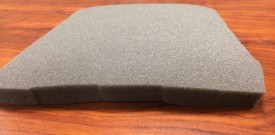 When I was primarily involved with screen printing and direct to garment printing, I was a huge proponent of 100% cotton t-shirts. I really didn’t think I could ever come to love those polyester shirts. But due to companies like Vapor Apparel, Under Armor and others, polyester performance wear has really started to take a hold of me. Now that my days are filled with sublimation inks and vinyl, instead of pretreatment and plastisol, I have been exposed to so much more polyester fabric that I almost feel like I nearly missed the boat. Using digital transfers on performance fabrics is a broad subject, so let’s start off by talking about some of the many different types of garments that are polyester based and the types of material that you can use to decorate those items.
When I was primarily involved with screen printing and direct to garment printing, I was a huge proponent of 100% cotton t-shirts. I really didn’t think I could ever come to love those polyester shirts. But due to companies like Vapor Apparel, Under Armor and others, polyester performance wear has really started to take a hold of me. Now that my days are filled with sublimation inks and vinyl, instead of pretreatment and plastisol, I have been exposed to so much more polyester fabric that I almost feel like I nearly missed the boat. Using digital transfers on performance fabrics is a broad subject, so let’s start off by talking about some of the many different types of garments that are polyester based and the types of material that you can use to decorate those items.
 Sports Jerseys – For years and years the sports jersey and performance fabric industry was dominated by dye houses and vinyl lettering. There was a lot of cotton being used and still today that business is strong. Things have changed though, and the polyester performance jerseys are becoming the normal. No longer do you see the solid color jersey with the one or two color name and number on it. You are now seeing excellent design, multiple colors and more. On top of all that, the garment can enhance the athlete performance by wicking away moisture and keeping the athlete cooler. Jerseys today are no longer just to designate a number; they, and the digital transfers they are decorated with, are part of the athlete’s performance.
Sports Jerseys – For years and years the sports jersey and performance fabric industry was dominated by dye houses and vinyl lettering. There was a lot of cotton being used and still today that business is strong. Things have changed though, and the polyester performance jerseys are becoming the normal. No longer do you see the solid color jersey with the one or two color name and number on it. You are now seeing excellent design, multiple colors and more. On top of all that, the garment can enhance the athlete performance by wicking away moisture and keeping the athlete cooler. Jerseys today are no longer just to designate a number; they, and the digital transfers they are decorated with, are part of the athlete’s performance.
For me the sign that things were changing was at a national volleyball event I was coaching at two years ago. The big player in the volleyball world when it comes to apparel is Mizuno. At most of the national club volleyball events they have a large booth set up to sell and promote their products. I always peak in to see what they have and to add to my collection (yes I’m a bit of a volleyball nut). Right out front of the booth was a large banner that read “ASK US ABOUT SUBLIMATION JERSEYS!” Now you can go to their website and check out their sublimation and cut and sew offering. This was huge in my world because someone was actually talking to the public about sublimation.
On top of the moisture wicking properties, if you replace the vinyl with a fully sublimated item you remove another problem that the volleyball jersey world has along with some other sports. When you have the thick vinyl on the garment and you go to dive across the floor, if your back or chest sticks to the ground you stop pretty abruptly. I have seen some pretty beat up chins due to a jersey grabbing the floor and slamming the athlete’s chin right into the ground. Ouch!
Swimsuits – This garment has long been something where the athlete is looking for the swimsuit to help them move through the water faster. In 1924 the British Olympic Swim team wore outfits made of silk to reduce drag. Today’s swimsuit for the elite athletes more resemble shark skin that a swimsuit. The garments in between are typically made of polyester performance fabric. These suits provide the ideal comfort for a swimmer and also provide performance improvements.
The garments are many times decorated via the sublimation process, but you will also find these being decorated with vinyl. While I know I was somewhat knocking vinyl for the volleyball athlete, today’s thinner vinyl can be a great addition to a swimsuit. For a suit you will want to use the thinnest vinyl you can cut and also find something that has a very aggressive heat activated adhesive. This vinyl can be the standard color vinyl or many times you will also find swimsuits decorated with solvent imprinted vinyl. Let’s not leave out the screen printing process. You can use athletic plastisol ink to decorate most swimsuits, but I do recommend that you check with your ink supplier for their recommendation on the specific blend or material you are decorating.
 Socks – When you think of poly performance wear your first thought is normally not socks, but yes socks would fit into the performance wear arena. Ask marathon runners if they will wear any old sock and you might get socked (pun intended) in the mouth. These athletes take great measures to care for their feet and the sock they wear can go a long way to helping them perform. This goes for athletes outside of runners and includes bikers, outdoor enthusiast, soccer players and more. In today’s world those athletes not only want to protect their feet and keep them dry, but they also want to make a statement. Many athletes want to match their socks to their colorful shoes or show pride in their team or other object they wish to represent. Socks are no longer the white pieces of fabric pulled up below our knees with one or 2 color strips on it.
Socks – When you think of poly performance wear your first thought is normally not socks, but yes socks would fit into the performance wear arena. Ask marathon runners if they will wear any old sock and you might get socked (pun intended) in the mouth. These athletes take great measures to care for their feet and the sock they wear can go a long way to helping them perform. This goes for athletes outside of runners and includes bikers, outdoor enthusiast, soccer players and more. In today’s world those athletes not only want to protect their feet and keep them dry, but they also want to make a statement. Many athletes want to match their socks to their colorful shoes or show pride in their team or other object they wish to represent. Socks are no longer the white pieces of fabric pulled up below our knees with one or 2 color strips on it.
The socks that are being decorated are almost all being sublimated. The performance socks are typically 100% polyester in nature and the sublimation process will penetrate the sock and become part of the fiber so no additional layers are added to the sock. While it is best to use a jig to press the sock, sublimating a sock is a fairly simple process. Just print out your transfer and press both side of the sock. Check out this video for an up-close tutorial on how to sublimate socks.
 Kid’s Garments – Okay, so now you are thinking I have completely gotten off track, right? Well, not really. The idea of performance fabric is to keep moisture off the body. Well, if you have a two year old like I do, keeping him clean and dry is an all-day everyday feat. The garment manufactures have figured out that polyester is the best type of fabric to use to stave off stains and keep kids as dry as possible. Also, almost every set of pajamas my son has is a nice soft fluffy polyester fabric with brightly decorated dinosaurs, sports images or cars.
Kid’s Garments – Okay, so now you are thinking I have completely gotten off track, right? Well, not really. The idea of performance fabric is to keep moisture off the body. Well, if you have a two year old like I do, keeping him clean and dry is an all-day everyday feat. The garment manufactures have figured out that polyester is the best type of fabric to use to stave off stains and keep kids as dry as possible. Also, almost every set of pajamas my son has is a nice soft fluffy polyester fabric with brightly decorated dinosaurs, sports images or cars.
A majority of these items are decorated with the sublimation process. I have also seen plenty of these garments decorated with screen printing, embroidery, direct to garment and some are mixtures of several techniques. Just avoid the temptation to add bling or solvents as you have to remember that everything a child can get their hands on WILL go in their mouth. You will need to make sure that you have all of the required MSDS sheets and CPSIA certificate when jumping into this marketplace.
So now that you have some ideas of items to try to tackle for the performance fabric marketplace, let’s talk about some of the challenges and tricks for overcoming them.
One of the first issues you might find is that not all polyester fabric and garments are created equally. Just because the tag says it is 100% polyester does not mean that a garment is going to sublimate well. If you go talk to a typical t-shirt manufacturer and ask them if their shirts are sublimatable, they will say “sure, it is 100% polyester.” Then go ahead and ask them if they know what sublimation actually is or how it is done? Most of them will not, they just know people are asking them for sublimatable shirts and they have a polyester version of their cotton counterpart. Some garments might have too low of a thread count, surface treatments that will affect the transfer or low white points. I’d suggest that you test all garments before committing to use that type of performance fabric with a customer. I would also be wary of accepting customer supplied garments without being able to test them first.
 The other issue I frequently address is when the digital transfer substrate imprints a permanent line onto the garment. This happens because the heat needed to transfer items onto polyester and the accompanying pressure actually makes the polyester melt and it conforms to the edge of the transfer carrier. The way to eliminate this is through a little bit of trial and error, but a there are a few key points will make narrowing this down easier. The first and easiest way to eliminate this is to make the transfer carrier (paper, vinyl carrier sheet, mask etc.) larger than the heat press itself. The new issue could be that you see the heat press mark on the garment so at that point you have way too much pressure. The better way to eliminate this mark is by using a piece of high temperature foam. This foam will need to be cut to at least ½” smaller than the transfer carrier sheet, but it also must be bigger than the image area being transferred. Before pressing stick the foam into your heat press towards the edge so you can see it. Adjust the pressure on your heat press so the foam compacts to about half of its normal thickness. This will give you a good amount of pressure while not pushing down so hard as to imprint the transfer carrier’s edge. You will have to do your own testing to find your exact right temperature and pressure, but ideally you want the least amount of pressure and least amount of heat to still be able to get a clean, vibrant and washable transfer.
The other issue I frequently address is when the digital transfer substrate imprints a permanent line onto the garment. This happens because the heat needed to transfer items onto polyester and the accompanying pressure actually makes the polyester melt and it conforms to the edge of the transfer carrier. The way to eliminate this is through a little bit of trial and error, but a there are a few key points will make narrowing this down easier. The first and easiest way to eliminate this is to make the transfer carrier (paper, vinyl carrier sheet, mask etc.) larger than the heat press itself. The new issue could be that you see the heat press mark on the garment so at that point you have way too much pressure. The better way to eliminate this mark is by using a piece of high temperature foam. This foam will need to be cut to at least ½” smaller than the transfer carrier sheet, but it also must be bigger than the image area being transferred. Before pressing stick the foam into your heat press towards the edge so you can see it. Adjust the pressure on your heat press so the foam compacts to about half of its normal thickness. This will give you a good amount of pressure while not pushing down so hard as to imprint the transfer carrier’s edge. You will have to do your own testing to find your exact right temperature and pressure, but ideally you want the least amount of pressure and least amount of heat to still be able to get a clean, vibrant and washable transfer.
Polyester performance fabrics are here to stay and as a garment decorator you need to be able to create these for your customers. While they can present some new challenges, they can also bring much higher profit margins and much less competition as not all decorators can master performance fabric. Placing digital transfers onto performance fabrics is a worthwhile investment one you understand what you need to be successful. Hopefully this will be a great jump start to 2014 for you. Happy Decorating!
